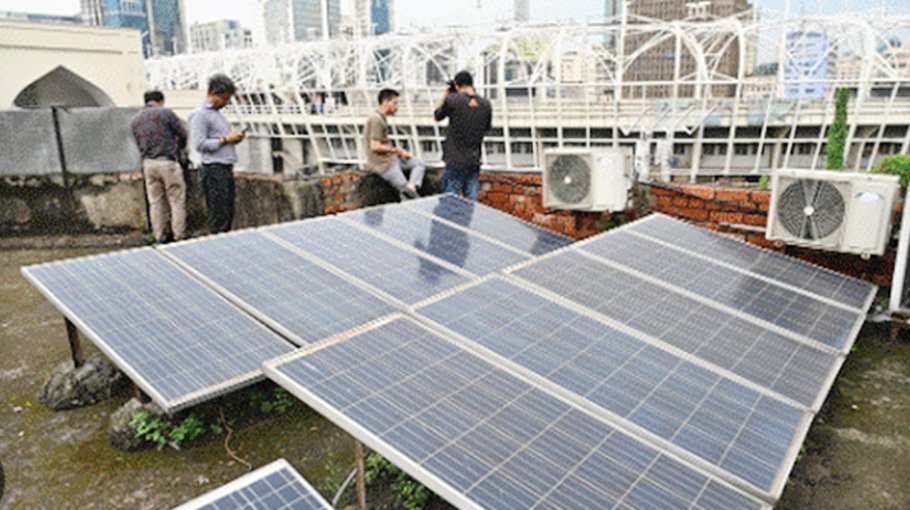Rooftop solar growth drags feet

Rooftop solar energy projects have enormous potential to generate clean energy, but the programmes have not grown as much as anticipated.
Challenges remain even with a record increase in 2023. Experts highlight the potential for significant savings and call for legislative action to remove adoption barriers.
The country’s rooftop solar capacity as of March 1, 2024, was only 166.28 MW, far short of the nation’s energy requirements, according to recent data. Presently, the nation generates 25,481 MW of electricity, primarily from plants that run on fossil fuels, which is a major cause of global warming. So, rooftop solar currently produces approximately 0.65% of the nation’s electricity.
Industry insiders argue that the government increased electricity rates once more in February 2024, having made multiple adjustments in 2023. The burden of high energy tariffs is currently falling on consumers and businesses alike, who are searching for a potential solution.
One of the primary producers and consumers of rooftop solar power may be the RMG and textile industries. A 400 MW solar photovoltaic system could be installed on the 42 million square feet of rooftop space owned by 1,500 members of the Bangladesh
Textile Mills Association, according to Infrastructure Development Company Ltd (IDCOL).
Factories could save 5 to 20 percent on grid power by using rooftop solar, according to an IFC study.
The greatest option might be rooftop solar PV to partially offset the use of fossil fuels. According to the government’s Power System Master Plan (PSMP), 635 MW, or 17.3%, of Bangladesh’s yearly energy can be generated on solar rooftops.
Approximately 576,200 tonnes of CO2 emissions will be decreased as a result.
Experts assert that ramping up rooftop solar capacity to 2,000 MW could offer substantial relief to the strained power grid and yield potential cost savings for the Bangladesh Power Development Board (BPDB).
Estimates suggest that such an expansion could save BPDB between Tk52.3 billion (US$476 million) and Tk110.32 billion (US$1 billion) annually by reducing reliance on costly power generation methods.
In a recent study, Shafiqul Alam, Lead Energy Analyst for Bangladesh at the esteemed international think tank Institute for Energy Economics and Financial Analysis (IEEFA), emphasised the growing economic feasibility of rooftop solar, particularly in light of several power tariff modifications during the previous 18 months.
Alam argued for changes to market design to encourage and de-risk rooftop solar investments in order to address these problems. He stressed the importance of utilising already-effective programmes and raising stakeholder awareness and capacity through SREDA-led initiatives.
Bangladesh saw a significant 42.04 MW capacity addition in 2023—the largest yearly increase since rooftop solar systems were first introduced in 2012. Positive momentum in the sector is indicated by regulatory changes implemented in August 2023, such as mandatory rooftop solar requirements for grid connections and international tenders for deployment in industries like jute mills.
Rooftop solar growth is, however, hampered by obstacles like low consumer awareness, high import duties on equipment, difficult financing, and regulatory limitations. Although there are financing options, most financial institutions are reluctant to finance rooftop solar projects because of perceived risks, so the opportunities are not sufficient to meet demand. Even though they are beneficial, initiatives like IDCOL’s financing plan are unable to satisfy demand overall.
To speed up the adoption of rooftop solar, policy recommendations call for duty waivers on solar accessories, streamlined financing procedures, payment targets for financial institutions, and the introduction of awards for outstanding projects.
The growth of rooftop solar is heavily dependent on utilities, but they also need new revenue streams and creative business plans. Successful implementation requires quality assurance measures, such as verifying the dependability of accessories and obtaining certification for service providers.
Stakeholders believe that capacity-building programmes and awareness campaigns are essential, and they urge the accelerated deployment of rooftop solar power by utilising already-effective models and improving sector coordination.
Experts stress, in order to address Bangladesh’s energy challenges and lessen reliance on fossil fuels, rooftop solar plays a crucial role. If action is delayed, there is a risk that important opportunities for the development of sustainable energy will be lost.
In a webinar recently held in the capital, the president of the Bangladesh Solar and Renewable Energy Association (BSREA), Engr Nurul Aktar voiced concerns about how low awareness and high import duties are impeding the adoption of rooftop solar power.
While acknowledging rooftop solar’s importance in IDCOL’s financing portfolio, Infrastructure Development Company Limited (IDCOL) CEO Alamgir Morshed also noted that rooftop solar is insufficient to meet sector demand. He emphasised how important it is to spread the word about the advantages of rooftop solar.
Professor Dr Ijaz Hossain, a former dean of BUET, recommended looking into feed-in tariffs and emphasised rooftop solar’s potential to help lessen pressure from other countries on export-oriented industries.
IEEFA South Asia’s Director, Vibhuti Garg, highlighted the role of blended financial instruments and falling solar technology costs while proposing novel business models like peer-to-peer trading and virtual net metering.
The Director General of Power Cell, Engineer Muhammad Hossain, underscored the shift in emphasis towards rooftop solar, given its significance in the context of initiatives to enhance grid quality and protect agricultural land.



